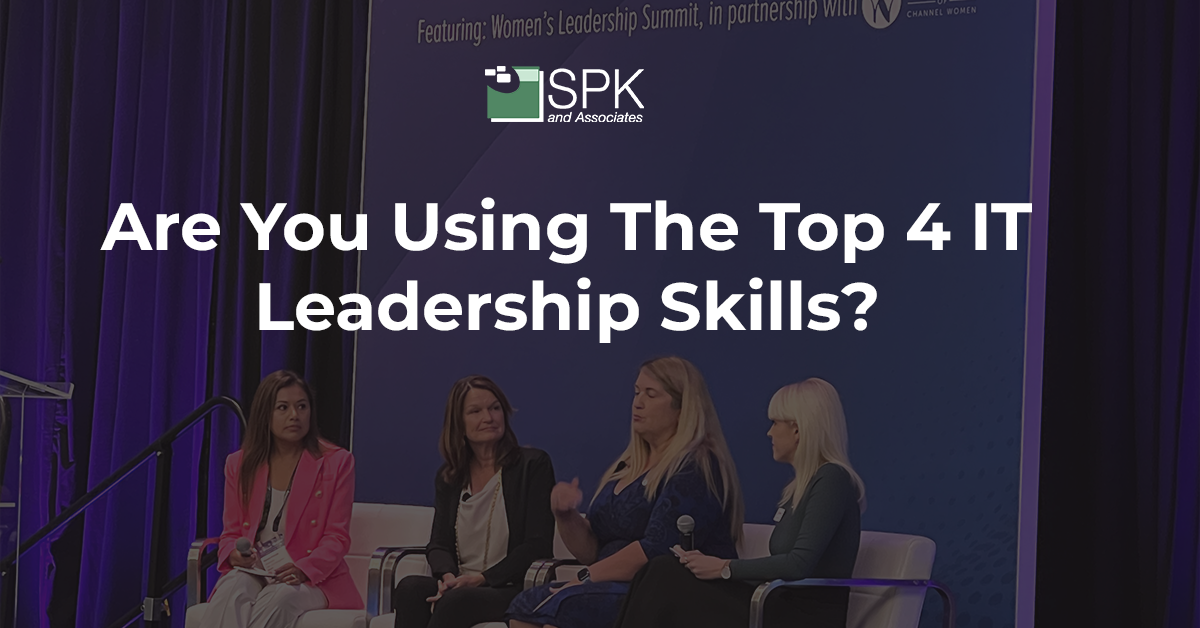Are you looking to transform yourself from an IT service provider “industry-follower” to, an IT leader? Then, you’ll probably find yourself wondering, “What are the best IT leadership tips for service providers?”
The 2022 MSP Summit, held on September 13 – 15, 2022, provided some insightful answers. But, the MSP Summit, and accompanying Women’s Leadership Summit, didn’t just provide meaningful and thought provoking insights. It also provided practical IT leadership tips.
MSP Summit 2022 Overview
I’m Christine McHale, co-founder and CEO of SPK and Associates. And, I had the honor of participating in 2-panel discussions during the conference: The New Channel and the Future You and Best Practices for Developing Teams and Influencing Culture.
There was a wide representation of IT service companies in attendance. However, there were strong common themes in the questions and concerns. Here are some of the common questions addressed around current IT leadership:

- How did the pandemic affect your company and leadership?
- As an IT leader, how are you now approaching your clients, employees, and partners?
- How are you addressing the seismic shifts taking place through the information and communications industry?
- What do you think about all the M&A activity in the industry and how should you address it?
- What are you doing to empower your teams, now remote work is an integral part of our makeup?
- In today’s environment, how do you build and maintain culture in your company?
The overarching theme and feeling among the participants was that the IT services industry has changed. Additionally, there is still significant change to come.
1. Adopt A Business First Approach
One key refrain which many IT leaders talked about was the need to approach technology from a business-first perspective. This is not a new refrain. Yet it is surprising to hear that many have not yet embraced it. Why? Because technologists tend to get entranced by the technology and lose sight of the real reasons for it.
An effective IT leader embraces the business need first:
-
-
- What key problem is the business unit facing?
- What are the results or outcomes that are considered successful?
-
Technology solutions should not be developed until the business issues are thoroughly understood. A strong IT leader takes the time to understand the business, its people and processes. They take this knowledge and learning seriously, and don’t just pay lip service.
2. Technical Specialization
Technical specialization is another key to IT leadership success. The technology sector increases in complexity each day. And the technology race is on, driving key differentiators for companies. No singular IT company or team can do it all. Understanding your core skills and competencies is vital. Then, the IT leader has to discipline themselves to stay within those competencies. Additionally, they need to adopt partnerships with other teams for technical needs outside of their core structure. Essentially, they create a culture of pulling in experts with core skills and competencies as needed whilst focusing on strengthening their own.

So, how do you partner effectively as an IT leader? Whilst there are multiple answers to this question, the key point to hone in on is are you set up for collaborative success. This means:
-
-
- Considering if you have adequate contracts and controls to support your collaboration.
- Defining systems, processes and supporting tools to drive smooth partnering.
-
Several IT leaders spoke about evolving into a true “trusted advisor” role with their clients. This comes about when you truly partner with your clients, whether they are external or internal. It brings us back to embracing the business needs first, and understanding those.
If the IT team has deep knowledge about their client’s business and industry and is willing to play that supporting role, they unconsciously become a valued trusted advisor.
3. IT Leadership Drives Great Culture
At the Summit, culture and employees were key topics. They go hand in hand. Undoubtedly, this interest has been heightened by:
-
-
- The pandemic.
- The “Great Resignation”.
-
A quick Google search provides you with a wide scope on the definition of culture. But, a simple one that applies to company culture from Collins Dictionary is:
The culture of a particular organization or group consists of the habits of the people in it and the way they generally behave.
Personally, I would also add that culture includes having shared vision and values. So, how can an IT leader drive a positive, supportive, and empowering culture? And, how can this be activated in a remote or hybrid workforce?
Many panelists noted that maintaining a shared company culture requires specific and recurring attention. You cannot just assume that culture will “happen.” While there is truth to the idea that culture is like a fragrance that spreads through space, it doesn’t happen without care and attention.
It is absolutely clear, and undeniable, that culture starts with the company leader. The leader’s values and priorities set the stage for the rest of the company.
But, how can this be best communicated to a remote workforce?
Most agreed that a periodic in-person get together was extremely important. These in-person meetings were critical to building rapport, sharing culture, and deepening relationships between staff.
In between these meetings, culture can be developed by consciously rewarding desired behavior. Additionally, it can be cultivated by having key company influencers model desired actions. Of course, it starts with hiring the right people. People who fit into your company community. People need to share similar values and motives. Without this, it’s almost impossible to create and support a shared culture.
4. Strong IT Leadership Enables Employee Empowerment
When considering how to empower and support employees, there were plenty of discussions at the Summit. Technical staff are intelligent, thoughtful, and increasingly care about the impact they are having with their work. Ultimately, many of these intelligent employees become demoralized, unmotivated, or resign when they find themselves shackled from empowerment, undervalued, bored with menial tasks, or poorly treated.
Empowering staff is the direct opposite of micromanaging staff. And, most managers realize how ineffective and undesirable micromanagement is. Yet we still find it everywhere.
Managing a hybrid or remote IT workforce requires attention and strategy. Micromanagement is a default behavior people resort to when they have no other options. It’s a fear strategy. It is not the strategy of a leader.
Empowering employees means giving them:
-
- Desired team and individual goals – drill down to provide each individual with their weekly or monthly goals and outcomes.
- Data intelligence – give them the data and metrics detailing how they are performing.
The best scenario is when each technical staff member can see for themselves if they are meeting their desired outcomes. Then they can see how to self-adjust to improve.
A remote or hybrid workforce requires empowered employees. It establishes the company’s success and establishes a content, happy workforce.
Conclusion
Four takeouts from the MSP Summit to be a great IT leader are:
1. A strong IT leader takes the time to understand the business’s people and the processes. They adopt a business first approach.
2. Play to your core skills and competencies. Then partner with other experts for technical expertise who play to theirs.
3. Culture starts with the leader of the company. The values and priorities of the leader set the stage for the company.
4. Being a strong IT leader requires you to let go of micromanagement. It requires you to empower your colleagues to take accountability and ownership.
The conference was fantastic. I highly recommend attending future events to deepen your knowledge on IT leadership, and network with other IT leaders.
At SPK and Associates, we continuously drive the above behaviors to accelerate our own business and be recognized as IT leaders. It means our customers can reap the benefits of working with us. We’ve been honored on both the Channel Futures MSP 501 List and the MSP 101 List.
If you would like to partner with us for your future projects, simply contact us here and we’ll arrange our team of experts to call you back.







